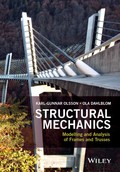Structural Mechanics: Modelling and Analysis of Frames and Trusses

1. Auflage Januar 2016
344 Seiten, Softcover
Wiley & Sons Ltd
Textbook covers the fundamental theory of structural mechanics and the modelling and analysis of frame and truss structures
* Deals with modelling and analysis of trusses and frames using a systematic matrix formulated displacement method with the language and flexibility of the finite element method
* Element matrices are established from analytical solutions to the differential equations
* Provides a strong toolbox with elements and algorithms for computational modelling and numerical exploration of truss and frame structures
* Discusses the concept of stiffness as a qualitative tool to explain structural behaviour
* Includes numerous exercises, for some of which the computer software CALFEM is used. In order to support the learning process CALFEM gives the user full overview of the matrices and algorithms used in a finite element analysis
1 Matrix Algebra 1
1.1 Definitions 1
1.2 Addition and Subtraction 2
1.3 Multiplication 2
1.4 Determinant 3
1.5 Inverse Matrix 3
1.6 Counting Rules 4
1.7 Systems of Equations 4
1.7.1 Systems of Equations with Only Unknown Components in the Vector a 5
1.7.2 Systems of Equations with Known and Unknown Components in the Vector a 6
1.7.3 Eigenvalue Problems 8
Exercises 10
2 Systems of Connected Springs 13
2.1 Spring Relations 16
2.2 Spring Element 16
2.3 Systems of Springs 17
Exercises 30
3 Bars and Trusses 31
3.1 The Differential Equation for Bar Action 33
3.1.1 Definitions 33
3.1.2 The Material Level 35
3.1.3 The Cross-Section Level 38
3.1.4 Bar Action 41
3.2 Bar Element 43
3.2.1 Definitions 43
3.2.2 Solving the Differential Equation 43
3.2.3 From Local to Global Coordinates 51
3.3 Trusses 55
Exercises 66
4 Beams and Frames 71
4.1 The Differential Equation for Beam Action 73
4.1.1 Definitions 73
4.1.2 The Material Level 74
4.1.3 The Cross-Section Level 75
4.1.4 Beam Action 78
4.2 Beam Element 80
4.2.1 Definitions 81
4.2.2 Solving the Differential Equation for Beam Action 81
4.2.3 Beam Element with Six Degrees of Freedom 90
4.2.4 From Local to Global Directions 92
4.3 Frames 95
Exercises 109
5 Modelling at the System Level 115
5.1 Symmetry Properties 116
5.2 The Structure and the System of Equations 120
5.2.1 The Deformations and Displacements of the System 121
5.2.2 The Forces and Equilibria of the System 130
5.2.3 The Stiffness of the System 132
5.3 Structural Design and Simplified Manual Calculations 144
5.3.1 Characterising Structures 144
5.3.2 Axial and Bending Stiffness 145
5.3.3 Reducing the Number of Degrees of Freedom 147
5.3.4 Manual Calculation Using Elementary Cases 149
Exercises 151
6 Flexible Supports 157
6.1 Flexible Supports at Nodes 157
6.2 Foundation on Flexible Support 159
6.2.1 The Constitutive Relations of the Connection Point 159
6.2.2 The Constitutive Relation of the Base Surface 161
6.2.3 Constitutive Relation for the Support Point of the Structure 163
6.3 Bar with Axial Springs 165
6.3.1 The Differential Equation for Bar Action with Axial Springs 165
6.3.2 Bar Element 167
6.4 Beam on Elastic Spring Foundation 171
6.4.1 The Differential Equation for Beam Action with Transverse Springs 171
6.4.2 Beam Element 173
Exercises 180
7 Three-Dimensional Structures 183
7.1 Three-Dimensional Bar Element 186
7.2 Three-Dimensional Trusses 188
7.3 The Differential Equation for Torsional Action 194
7.3.1 Definitions 194
7.3.2 The Material Level 195
7.3.3 The Cross-Section Level 197
7.3.4 Torsional Action 202
7.4 Three-Dimensional Beam Element 203
7.4.1 Element for Torsional Action 204
7.4.2 Beam Element with 12 Degrees of Freedom 205
7.4.3 From Local to Global Directions 206
7.5 Three-Dimensional Frames 209
Exercises 213
8 Flows in Networks 217
8.1 Heat Transport 219
8.1.1 Definitions 219
8.1.2 The Material Level 222
8.1.3 The Cross-Section Level 224
8.1.4 The Equation for Heat Conduction 225
8.1.5 Convection and Radiation 227
8.2 Element for Heat Transport 229
8.2.1 Definitions 230
8.2.2 Solving the Heat Conduction Equation 230
8.3 Networks of One-Dimensional Heat-Conducting Elements 235
8.4 Analogies 242
8.4.1 Diffusion - Fick's Law 242
8.4.2 Liquid Flow in Porous Media - Darcy's Law 243
8.4.3 Laminar Pipe Flow - Poiseuille's Law 244
8.4.4 Electricity - Ohm's Law 245
8.4.5 Summary 246
Exercises 247
9 Geometrical Non-Linearity 251
9.1 Methods of Calculation 252
9.2 Trusses with Geometrical Non-Linearity Considered 255
9.2.1 The Differential Equation for Bar Action 256
9.2.2 Bar Element 257
9.2.3 Trusses 260
9.3 Frames with Geometrical Non-Linearity Considered 262
9.3.1 The Differential Equation for Beam Action 262
9.3.2 Beam Element 265
9.3.3 Frames 274
9.4 Three-Dimensional Geometric Non-Linearity 277
Exercises 278
10 Material Non-Linearity 281
10.1 Calculation Procedures 282
10.2 Elastic-Perfectly Plastic Material 284
10.3 Trusses with Material Non-Linearity Considered 285
10.4 Frames with Material Non-Linearity Considered 289
Exercises 298
Appendix A Notations 301
Appendix B Answers to the Exercises 303
Index 323


